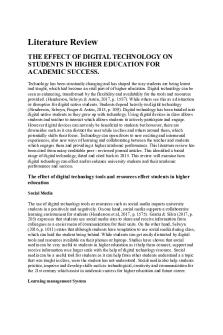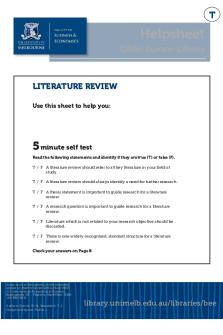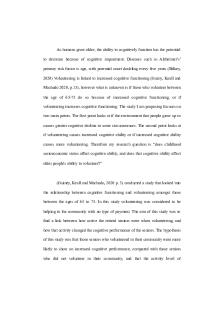Literature Review PDF

| Title | Literature Review |
|---|---|
| Course | Professional Communication 2 |
| Institution | Queensland University of Technology |
| Pages | 32 |
| File Size | 295.5 KB |
| File Type | |
| Total Downloads | 13 |
| Total Views | 163 |
Summary
Lit review...
Description
Literature Review THE EFFECT OF DIGITAL TECHNOLOGY ON STUDENTS IN HIGHER EDUCATION FOR ACADEMIC SUCCESS. Technology has been constantly changing and has shaped the way students are being learnt and taught, which had become an vital part of of higher education. Digital technology can be seen as enhancing, transformed by the flexibility and availability for the tools and resources provided. (Henderson, Selwyn & Aston, 2017, p. 1587). While others see this as a distraction or disruptive for digital native students. Students depend heavily on digital technology (Henderson, Selwyn, Finger & Aston, 2015, p. 309). Digital technology has been braided into digital native students as they grew up with technology. Using digital devices in class allows students and teacher to interact which allows students to actively participate and engage. However digital devices can not only be beneficial to students but however, there are downsides such as it can distract the user while in class and others around them, which potentially shifts their focus. Technology can open doors to new exciting and interneural experiences, also new ways of learning and collaborating between the teacher and students which engages them and providing a higher academic performance. This literature review has been cited from many creditable peer - reviewed journal articles. This identified a broad range of digital technology, dated and cited back to 2015. This review will examine how digital technology can effect and/or enhance university students and their academic performance and success.
The effect of digital technology tools and resources effect students in higher education Social Media The use of digital technology tools or resources such as social media impacts university students in a positively and negatively. On one hand, social media supports a collaborative learning environment for students (Henderson et al, 2017, p. 1575). Garcia & Silva (2017, p. 205) expresses that students use social media sites to share and receive information from colleagues as a easier mean of communication for their units. On the other hand, Selwyn (2016, p. 1011) states that although students have temptation to use social media during class, which can lead the student being behind. While students can get easily distracted by digital tools and resources available on their phones or laptops. Studies have shown that social media can be very useful to students in higher education as it help them connect, support and receive information on a larger scale with the help of digital technology resource. Social media can be a useful tool for students as it can help from other students understand a a topic that was taught in class, were the student has not understood. Social media also help students practice, improve and develop skills such as technological, creativity and communication for the 21st century which assist in academic success for higher education and future career. Learning management System
The learning management system plays an vital role which enhance learning and teaching for students, universities provide important information to students through Blackboard, library and other learning platforms used in classes. Henderson et al (2017, p. 1576) claims that Learning management systems such as blackboard is useful for students as they can find all information related to their subject in one place such as assignments and resources. LMS and digital technology has been embedded in higher education that students and university would find it difficult to imagine without (Henderson et al, 2015, p. 311). However, Selwyn (2016, p. 1014) states that poorly configured learning management systems can be frustrating for students as the Blackboard unavailable at a certain time which leads to delays in assignment and getting the information required during studying. Learning management system depends a lot on technology such as blackboard, it allows students to check assessment, class requirements the studies show that Blackboard have an advantage for students as it provides access to learning material such as access to the library, pro quest and other academic site access also feedback which can enhance academic success.
The positive and negative usefulness of digital technology that enhance academic success Distraction In terms of a negative effect of digital technology. Digital devices such as laptops, mobile phones devices, table devices and smart watch are integrated and widely used during class, this devices are seen to have a huge influence on education success in the Morden era. According to McCoy (2016, p. 10) students frequently use their digital devices most of their times in the classrooms, however this are not always for academic purpose. Similarly, Garcia & Silva (2017, p. 210) states that the uses general use of digital technology devices as a mean of procrastination. On the other hand not only are the students using their devices while in class but also distract other students in the lecture and tutorial, which also leads them to lose tract and focus during class. (Selwyn 2016, p. 9). Universities encourage student to use their digital devices as they can communicate and collaborate in real time however, there are many disadvantages in particular distraction, students divert their attention then start procrastinate and while physically distraction other students by digital devices. These digital technology tool and resources can have a great negative effect on students performance and success in university. Self directed learning Self directed learning (SDL) is encouraged as one of the most vital skill in the 21st century, as it IS A technology rich learning environment that students are given the ability to learn in various styles suited to them. Henderson et al (2015, p. 317) claims that digital technology allows student to learning on their own and more convenient time suited to the students. Students are responsible for their own learning process, which promotes self regulated learning (West, Moore & Barry, 2015, p. 166). Stated by Kizil (2017, p. 383) student have a desire to obtain information quickly, while demanding instant updates and feedback. Although Self directed learning can be difficult for some students for example time management and understanding the information found, most courses in higher education require SDL. Self directed learning provides an opportunity for students a flexible time to study and learn, it suits their own pace and understanding to learn and apply knowledge and skill learnt. In addition learning can broaden students ability to communicate, critically think
and encourage creative problem solving; all these skills promote and aid in a successful academic performance.
Conclusion Digital technology is a highly effective tools, there are many advantages and disadvantages of students in higher education utilizing digital technology tools and resources that effect and enhance academic performance at university. While there are many tools and resources in particularly social media, learning management systems and self directed learning, there are apparent downsides such as distraction. Digital technology has been integrated into university as part of the teaching and learning experience which has benefited students academic success. As this literature review identified in the beginning, there are various research studies about digital technology and students in higher education success. However it can be encouraged that universities develop and improve digital technology for a more reliable, user friendly and accessibility of tools and resources provided for successful students performance. Words: 1175
SUMMARY NOTES DUE PART 3
Literature Review Garcia, L, S & Silva C, M, C. (2017) Author and date
Notes
Leandro Sumida Garcia, Camila Mariane Costa Silva
2017
Brazil
Comments (using your notes and your own voice, construct 2 - 3 sentences)
These Authors is from Brazil.
Aim or Scope
Notes
social media and institutional communication channels in higher education
perception of usefulness
user satisfaction
Comments (using your notes and your own voice, construct 2 - 3 sentences)
The article investigates how social media sites and institutional communication channels in higher education are perceived as useful in a virtual learning platform and environment.
Participants, when and where
Notes
Brazilian Public university , Sau Paulo
108 students
40 females, 68 males
50 students 18 to 20, 39 students 21-23 and 19 students 24 to 26
93 enrolled in science and engineering and 15 in Humanities
Comments (using your notes and your own voice, construct 2 - 3 sentences)
The participants in the study were taken from a Brazilian Public university in Sau Paulo There were 108 students between the ages 18 to 26.
Context and framework
Notes
120 questionnaires handed out on campus for 3 days
usefulness
academic activities
Comments (using your notes and your own voice, construct 2 - 3 sentences)
Participants were asked to complete surveys handed out on campus, which were asked to the general use and comparison of usefulness and academic activities with social media and institutional communication.
Main results or findings
Notes
perceive useful when using social media
for information provided at university
Better use of technology resources
No technical support provided
Formal and informal channels media
Comments (using your notes and your own voice, construct 2 - 3 sentences)
The results founded in this study states that students prefer using social media useful and a significant impact. It helps develop and improve academic activities and support, however students do not receive technical support.
Limitations & Additional information
Notes
Small sample size
Small age gap
one university
Comments (using your notes and your own voice, construct 2 - 3 sentences)
The limitations of this investigation is that it was conducted in only in Brazil. It had a very small sample size and age group.
McCoy, B, R. (2016) Author and date
Notes
Bernard R. McCoy
2016
University of Nebraska
Comments (using your notes and your own voice, construct 2 - 3 sentences)
These Author is from University of Nebraska
Aim or Scope
Notes
distractions of using digital devices (phones)
learn behaviours and perception in classroom and non classroom purpose with the use of digital technology
impact of student learning
Effect of texting, twitter and message content
Comments (using your notes and your own voice, construct 2 - 3 sentences)
The article investigates how digital devices university students are using in their studies and how much of a distraction and effect it has on student learning.
Participants, when and where
Notes
675 students
65.4% females, 34.6% males
American colleges and university in 26 states
majority mass communication
Comments (using your notes and your own voice, construct 2 - 3 sentences)
The participants in the study were taken from a 26 states American colleges and states. There were 675 students majority enrolled in a mass communication class.
Context and framework
Notes
Research collected in 2015
Online survey question (survey monkey)
About 15 questions
addressing frequency, duration, and intensity of distraction in class and out
Geolocation was tagged
Quantitative Research
Comments (using your notes and your own voice, construct 2 - 3 sentences)
Participants were asked to complete online survey about their engagement with digital devices and he positive and negative effects, as well as their frequency and duration of use.
Main results or findings
Notes
using devices for non classroom use was very little
Many use was texting
Advantage - stay connected, fight boredom, entertainment
Disadvantage - don't pay attention, miss instructions, distract others
Comments (using your notes and your own voice, construct 2 - 3 sentences)
The results founded in this study states that students prefer using their own devices, however they get distracted or distract other. Which has more disadvantage than benefits of bring own devices into the classroom.
Limitations & Additional information
Notes
Small sample size
larger female respondents
Taken in only America
Comments (using your notes and your own voice, construct 2 - 3 sentences)
The limitations of this investigation is that it was conducted in only in America which can not be related to other universities and/or countries around the world. This study could have a bigger sample size and equal the female and male ratio.
Notes Use this space to plan, take notes, and collate research. Here are some handy hints for planning and organising your assignment:
Analyse the task
Make a plan
Research and find information
Create an outline
Write a first draft
Create and update your reference list
Refine and edit your work (second draft)
Proofread (final draft)
Submit
~-Henderson, M., Selwyn, N., Finger, G., & Aston, R. (2015). Students' everyday engagement within digital technology in university: exploring patterns of use & usefulness. Journal of Higher Education policy and management. 37(3), 308-319 doi:1080/1360080x.2015.1034424 -Kizil, A.S. (2017). EFL learners in the digital age: an investigation into personal and educational digital engagement. RELC Journal, 48(3), 373-388. doi:10.1177/006882|6684285 @~`Selwyn, N. (2016). Digital downsides: explore university students' negative engagements with digital technology. Teaching in Higher Education, 21(8), 1006-1021. doi:10.080/13562517.2016.1213229 -West, B., Moore, H., & Barry, B. (2015). Beyond the tweet: using twitter to enhance engagement, learning and success among first - year students. Journal of Marketing Education, 37(3), 160 - 170. doi:10.1177/0273475315586061 ~Henderson, M., Selwyn, N., & Aston, R. (2017). What works and why? students perception of 'useful' digital technology in university teaching and learning. Studies in Higher Education, 42(8), 1567-1579. doi:10.1080/03075079.2015.1007946 `McCoy, B, R. (2016). Digital distraction in the classroom phase II: student classroom use of digital devices for non - class related purpose. Faculty Publication, College of Journalism & Mass Communication, (90).
Kent, M. (2016). Adding to the mix: students use of Facebook groups and blackboard discussion forums in higher education. Knowledge Management & E - Learning, 8(3), 444463 @`Garcia, L, S & Silva C, M, C. (2017) Differences between perceived usefulness of social media and institutional channels by undergraduate students interactive. Technology and Smart Education, 14(3).196-215. doi:10.1108/ ITSE-01-2017-0009
WEEK 6 Blue Reading Author and date
Notes
Michael Henderson, Neil Selwyn, Glenn Finger & Rachel Aston
2015
Faculty of Education, Monash University, Arts, Education and Law Groups, Griffith University
Comments (using your notes and your own voice, construct 2 - 3 sentences)
These Authors are from big universities in Australia.
Aim or Scope
Notes
Students everyday engagement with Technology at university. The patterns of use and usefulness
The digital devices and resources that students use most frequently during university studies
What technology is used for
Perception of usefulness attached to these uses
Investigate engagement with digital technology
Comments (using your notes and your own voice, construct 2 - 3 sentences)
The article aims to investigate which digital devices university students are using in their studies and how useful they find these device. This article focus on student perception of usefulness.
Participants, when and where
Notes
2 large Australian universities (South-east & North-east)
Universities of similar size
multiple campuses with undergraduate and postgraduate levels
different faculty
international and domestic students
1658 students
Undergraduate
Ages 17 to 66
945 females, 473 males
627 first year, 395 second year, 347 third year, 287 fourth and above
Comments (using your notes and your own voice, construct 2 - 3 sentences)
The participants in the study were taken from 2 large universities, South-east and North-east of Australia. Both university were of similar size, there was 1658 undergraduate students ages between 17 to 66, both international and domestic and in different faculty.
The participants in the study comprised both domestic and international undergraduate students. In total of 1658 student took part in the research. These students were enrolled in a number of different faculties across the campuses. While the students ranged in ages from 17 to 66 the mean age was 22.
Context and framework
Notes
Research collected in 2014
self - selecting
Undergraduate students completed online questionnaire/survey
Survey data investigating type and level of digital technology usefulness to their university studies
engagement with technology
thematic analysis...
Similar Free PDFs

Literature Review
- 10 Pages

Literature Review
- 9 Pages

Literature Review
- 6 Pages

Literature Review
- 32 Pages

Literature Review
- 9 Pages

Literature Review
- 5 Pages

Literature Review
- 15 Pages

Literature Review
- 4 Pages

Literature Review
- 16 Pages

Systematic Literature Review
- 9 Pages

Mobile Learning Literature Review
- 26 Pages

Literature review on IFRS
- 11 Pages

Literature Review - guidelines
- 4 Pages

Chapter-2: LITERATURE REVIEW
- 48 Pages

Distance Education Literature Review
- 12 Pages
Popular Institutions
- Tinajero National High School - Annex
- Politeknik Caltex Riau
- Yokohama City University
- SGT University
- University of Al-Qadisiyah
- Divine Word College of Vigan
- Techniek College Rotterdam
- Universidade de Santiago
- Universiti Teknologi MARA Cawangan Johor Kampus Pasir Gudang
- Poltekkes Kemenkes Yogyakarta
- Baguio City National High School
- Colegio san marcos
- preparatoria uno
- Centro de Bachillerato Tecnológico Industrial y de Servicios No. 107
- Dalian Maritime University
- Quang Trung Secondary School
- Colegio Tecnológico en Informática
- Corporación Regional de Educación Superior
- Grupo CEDVA
- Dar Al Uloom University
- Centro de Estudios Preuniversitarios de la Universidad Nacional de Ingeniería
- 上智大学
- Aakash International School, Nuna Majara
- San Felipe Neri Catholic School
- Kang Chiao International School - New Taipei City
- Misamis Occidental National High School
- Institución Educativa Escuela Normal Juan Ladrilleros
- Kolehiyo ng Pantukan
- Batanes State College
- Instituto Continental
- Sekolah Menengah Kejuruan Kesehatan Kaltara (Tarakan)
- Colegio de La Inmaculada Concepcion - Cebu
